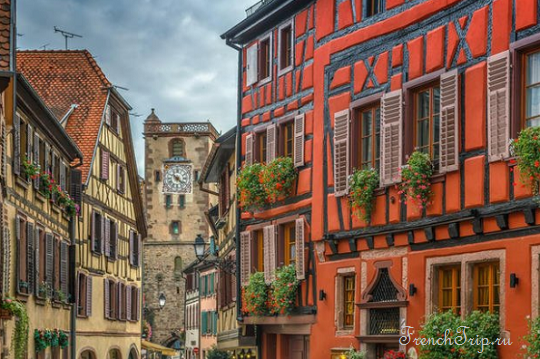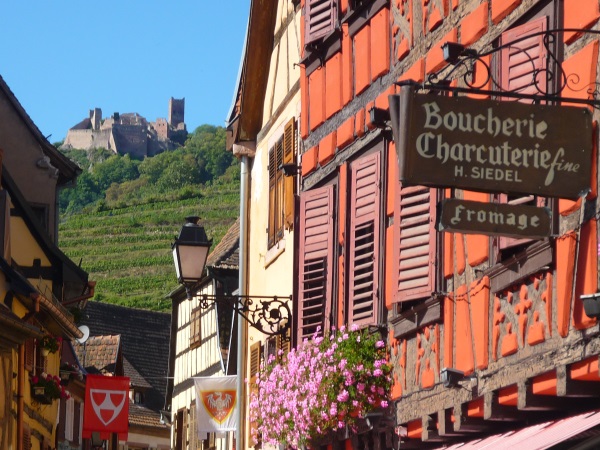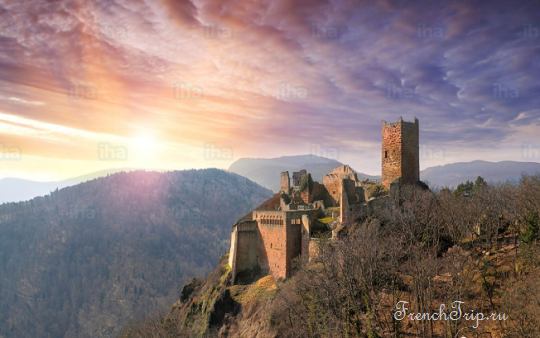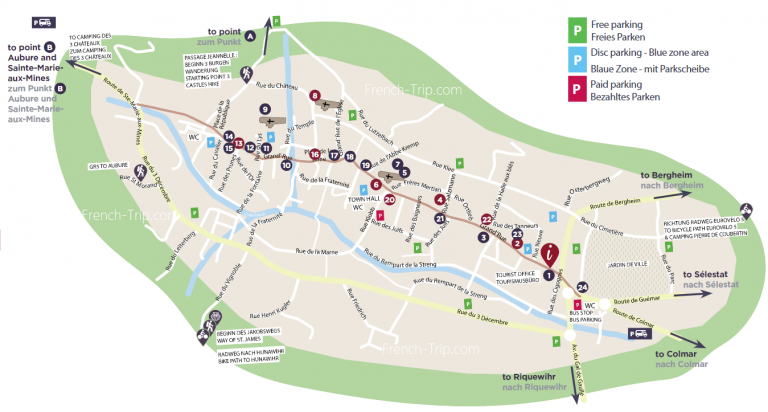Self-Guided Walking Tour of Ribeauvillé
Self-Guided Walking Tour of Ribeauvillé will take you through the historical center of the city and introduce you to all the main attractions. The walk will take approximately a couple of hours, not including visits to wineries or museums.
Walking Tour of Ribeauvillé on the map:
Tourist route around Ribeauville:
The route starts from the city’s tourist office – Office de Tourisme (1 Grand’Rue).
1) Vintner’s fountain
1 Grand’Rue
Constructed in 1909, it highlights the significant role of viticulture in the local economy. Situated in front of the Tourist Office, this building once served as the octroi house, where taxes were collected on goods entering and exiting the lower part of the city.
2) Pfifferhüss
14, Grand’rue
The oriel of the Maison des Ménétriers dates from 1663 and bears the words: “Ave Maria Gracia Plena”, referring to the Dusenbach pilgrimage (see point B below) dedicated to the Virgin Mary. The Brotherhood of the Minstrels of Alsace, chronicled since 1390, was placed under the protection of the lords of Ribeaupierre.
3) Auberge à l’Eléphant
Place de la 1 ère Armée
It has been an inn ever since it was founded in 1522. The elephant can be seen on the side of the building.
4) House with oriel
in rue Ortlieb
Renaissance house (16th century).Its yellow sandstone oriel is decorated with the sculpted heads of the former owners.
5) Church of the Convent
Place de l’Hôtel de Ville
The Augustinians’ church founded in the 14th century and abandoned during the Revolution became the church of the Convent of the Sisters of the Divine Providence in 1819. Don’t miss the remarkable gothic portal, the interior in gothic style (guided tours only) as well as a canonical sundial (*1) located at the corner of the sacristy, at the start of the rue des Frères Mertian.
6) Butchers’ Tower
Grand’Rue
It was built in 1260 and raised in 1536, separating the upper and lower parts of the town. It was threatened with destruction several times. Today it is the emblem of the city and reaches a height of 29 m. It owes its name to the slaughterhouse and butchers’ stalls that once stood at its foot.

7) Porte des Pucelles (The vigins gate)
rue de l’Abbé Kremp
It is built on the northern rampart of the middle town. The present gate was built in 1780 after the original building collapsed in 1778. This name comes from a translating error referring to the Virgin Mary, installed in a niche of the original door. The blazon on the town side represents the Ribeaupierre family arms.
8) Saint Gregory’s church
Grand’Rue de l’Eglise
It dates from the 13th and 15th centuries. It contains several notable features: a Silbermann organ (1701), the Mount of Olives (15th century) from the Dusenbach convent, a Virgin and Child (circa 1500) called the “Madone de la Petite Verrerie”, and also the “Maria Raydt” chapel with liturgical furniture created in 2017 by Christoff Baron, the artist from Strasbourg.
9) Protestant Church
Place Spener
It dates back to 1783. The bell tower was added in 1898. It borders Place Spener, named after the father of pietism(2). His portrait can be found inside the building.
10) Pieta de 1788
112 Grand’Rue
The “House of the Dusenbach” owes its name to the statue of the Virgin in the facade wall. Visitors would leave their horses here to go to the Dusenbach monastery (see point B).
11) Former smithy and lords’ mill
116 Grand’Rue
The old “lords’ mill” used to have a paddle wheel. This mill supplied flour to the 4th castle of the lords until the Revolution. It was changed into a carpentry that used the same wheel until 1970. The building is followed by the lords’ former smithy, with a historical listed facade.
12) Dissler House
1 rue du Lys
Beautiful half-timbered house with a corner post representing a blacksmith with his apron and leather boots. Wet leather offered protection from the heat of the forge.
13) Place du Bouc
The “Stadtbach” which flows here was used for washing laundry until 1965. Nearby, a Renaissance house with a spiral staircase, corbels and sculptured corner posts.
14) Place de la République
At the top of this square was located the “Porte Haute”. On the right, the Jeannelle passage marks the beginning of the western rampart with its witch tower. The fountain built in 1899, has a central column dated 1576, which comes from the fountain on Place de la Sinne.
15) Carriage entrance
1 place de la République
Magnificent carriage door with twisted arches. This architectural feature made it easier for carts and carriages to enter.
16) Place de la Sinne and Fontaine Friedrich
The statue above the fountain was sculpted in 1862 by André Friedrich, who was born in Ribeauvillé. It represents the town of Ribeauvillé, its agriculture and industry. The former fountain was used as a communal gauge, hence its name (Sinne). This square is the address of the Auberge du Soleil (formerly the meeting place of minstrels), the Auberge du Mouton (former coaching inn) and the Cour du Grand Bailli (former administrative centre of the entire seigniory of Ribeaupierre).
17) House of J.B Wendling
1 place de la République
Magnificent carriage door with twisted arches. This architectural feature made it easier for carts and carriages to enter.
18) Auberge au Cerf and fountain
81 Grand’Rue
The 16th-century fountain bears the coat of arms of the Ribeaupierre family. Jean-Jacques, the last lord, lived in this house and died there in 1673.
19) Siedel House
8 Grand’Rue
This very beautiful Renaissance house has remarkable timbers with curule seat patterns. Sev-eral “guglochs” are visible: these are small side windows that allow you to look out without being seen.

20) Town Hall
Dated 1778, it houses a collection of hanaps(3) in solid silver presented to the town by the lords of Ribeaupierre. The walls of the “Red Room” (town council hall) are covered with Turkey red fabric manufactured by Ets Steiner (now Beauvillé) around 1882.
21) Saint Catherine’s Chapel
Grand’Rue
The chapel of the seigniorial hospital, attested since 1346, serves as a burial place to the Ribeaupierre family, whose arms are on the remarkable ogival keystone of the choir. Today, it is an exhibition hall.
22) Former corn market andfountain
Place de la 1ère Armée
The former corn market that was mentioned as early as 1431 housed the corn collected as taxes by the feudal lords. The façade still has its two Gothic porches. The fountain dates from 1559.
23) Maison des Tanneurs
12 rue des Tanneurs
The tanner’s house dates back to the 16th century. The open-ings in the roof were made to allow the hides to dry.
24) City Garden
Route de Guémar
The former pleasure garden of the lords of Ribeaupierre has a very fine view of the three castles.
Sights outside the tour
A) The Three Castles
In the imagery of Alsace, Ribeauvillé is famous for its three castles situated on the same hill, towering above the town and the plain with their majestic figures. Saint Ulrich castle was the ordinary residence of the powerful lords of Ribeaupierre until the beginning of the 16th century and is one of the most prestigious castles of Alsace. Together with the neighbouring Haut-Ribeaupierre (12th century) and Giersberg (13th century), they form a first-rate feudal complex among the main historical sites of Alsace.

B) The Pilgrimage of Our Lady of Dusenbach
Since the Middle Ages, Our Lady of Dusenbach is one of the most famous and popular pilgrimages of the Virgin Mary in Alsace. It owes its origin to Eguenolphe de Ribeaupierre, who brought back a statue of the Virgin Mary from his crusade to the Holy Land (early 13th century). He installed it in a chapel built for that purpose in the Dusenbach valley. Over the centuries, the site was destroyed and then rebuilt three times thanks to the generosity of the faithful. The last reconstruction dates from 1894. That was followed in 1903 by the addition of the great church, which was finally consecrated in 1912. The Capuchin friars who have been here since 1904 extend a warm welcome to those who visit this place of peace and contemplation.
Glossary
(*1) Canonical sundial: used to indicate the start of liturgicalacts to the members of a religious community.
(*2) Pietism: important Protestant religious movementfounded by Philipp Jacob Spener (1635-1705), born in Ribeauvillé.
(*3) Hanaps: seventeenth century vermeil goblets anddrinking cups
→ Back to Ribeauvillé travel guide
Archives
Calendar
| M | T | W | T | F | S | S |
|---|---|---|---|---|---|---|
| 1 | 2 | 3 | 4 | 5 | 6 | 7 |
| 8 | 9 | 10 | 11 | 12 | 13 | 14 |
| 15 | 16 | 17 | 18 | 19 | 20 | 21 |
| 22 | 23 | 24 | 25 | 26 | 27 | 28 |
| 29 | 30 | 31 | ||||
